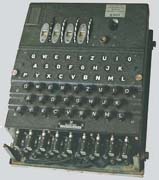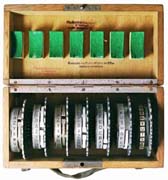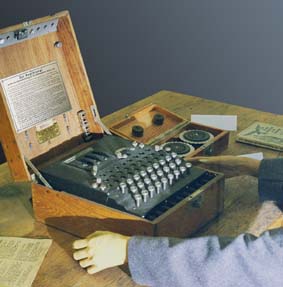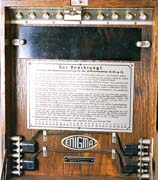Konrad Knirim's Choice:
|
der Wehrmacht im 2. Weltkrieg Hersteller: Heimsoth & Rinke Berlin |
Producer: Heimsoth & Rinke, Berlin/Germany |
 |
 |
 |
 |
| Beschreibung:
Dieses ist keine Uhr, aber ein interessantes militärisches Gerät. Die Verschlüsselungsmaschine Enigma: - Entwickelt von Arthur Scherbius, hergestellt von Heimsoth & Rinke Berlin war diese Maschine die Basis der gesamten deutschen Funkverschlüsselung. Allein bis Ende 1942 sind etwa 100.000 Geräte hergestellt worden. Die Standardversion hatte drei Walzen (links oben), die Enigma M der U-Boote vier, jeweils zur Auswahl standen 7 Walzen und 26 Elektrokontakte mit insgesamt 150 x 10 hoch 18 Kombinationsmöglichkeiten. Die Codierungen wurden fast täglich geändert, dennoch wurde der Code vom britischen Geheimdienst geknackt. - recht: Luftwaffen-Version mit den zwei zusätzlichen Walzen und dem Handbuch, Luftwaffenmuseum Berlin-Gatow) - links: Verschlüsselungsmaschine Enigma Nr. M Na 220900 vom Marineoberkommando Norwegen. Einsatz:
|
Description:
Encrytion machine Enigma: Developed by Arthur Scherbius, made by Heimsoth & Rinke, Berlin, this machine was the basis of the entire German radio encoding. Up to the end of 1942 alone, about 100.000 instruments were produced. The standard type had three cylinders, the Enigma M of the submarines had four, in each case 5 cylinders and 26 electric contacts with 150 x 10 to the 18th power were to choose from. The encodings were changed almost daily. - left: coding machine Enigma no. M Na 220900 of the German Navy High Command Norway: the standard version had three coding wheels (top left), the version ‘M’ for the submarines (code name ‘shark’) had four. Together with 7 alternative wheels and 26 electrical contacts there were at all 150 x 10 power18 possible combinations. Though the coding was changed according to the code book, it was decoded by the British Intelligence Service. - right: Luftwaffe version here with the two extra cylinders and the handbook, Museum of the Luftwaffe, Berlin-Gatow Application:
|